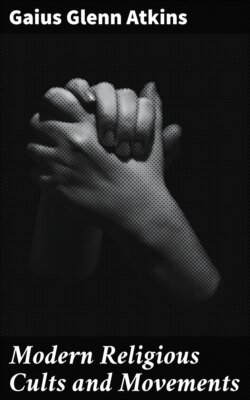Читать книгу Modern Religious Cults and Movements - Gaius Glenn Atkins - Страница 3
На сайте Литреса книга снята с продажи.
Introduction
ОглавлениеTable of Contents
The last thirty years, though as dates go this is only an approximation, have witnessed a marked development of religious cults and movements largely outside the lines of historic Catholicism and Protestantism. One of these cults is strongly organized and has for twenty years grown more rapidly in proportion than most of the Christian communions. The influence of others, more loosely organized, is far reaching. Some of them attempt to give a religious content to the present trend of science and philosophy, and, generally, they represent the free movement of what one may call the creative religious consciousness of our time.
There is, of course, a great and constantly growing literature dealing with particular cults, but there has been as yet apparently no attempt to inquire whether there may not be a few unexpectedly simple centers around which, in spite of their superficial differences, they really organize themselves.
What follows is an endeavour in these directions. It is really a very great task and can at the best be only tentatively done. Whoever undertakes it may well begin by confessing his own limitations. Contemporaneous appraisals of movements upon whose tides we ourselves are borne are subject to constant revision. One's own prejudices, no matter how strongly one may deal with them, colour one's conclusions, particularly in the region of religion. The really vast subject matter also imposes its own limitations upon even the most sincere student unless he has specialized for a lifetime in his theme; even then he would need to ask the charity of his readers.
Ground has been broken for such an endeavour in many different directions. Broadly considered, William James' "Varieties of Religious Experience" was perhaps the pioneer work. Professor James' suggestive analyses recognize the greatly divergent forms religious experience may take and establish their right to be taken seriously as valid facts for the investigator. The whole tendency of organized Christianity—and Protestantism more largely than Catholicism—has been to narrow religious experience to accepted forms, but religion itself is impatient of forms. It has its border-lands, shadowy regions which lie between the acceptance of what Sabatier calls "the religions of authority" on the one hand and the conventional types of piety or practical goodness on the other. Those who find their religion in such regions—one might perhaps call them the border-land people—discover the authority for their faith in philosophies which, for the most part, have not the sanction of the schools and the demonstration of the reality of their faith in personal experience for which there is very little proof except their own testimony—and their testimony itself is often confused enough.
But James made no attempt to relate his governing conceptions to particular organizations and movements save in the most general way. His fundamentals, the distinction he draws between the "once-born" and the "twice-born," between the religion of healthy-mindedness and the need of the sick soul, the psychological bases which he supplies for conversation and the rarer religious experiences are immensely illuminating, but all this is only the nebulæ out of which religions are organized into systems; the systems still remain to be considered.
There has been of late a new interest in Mysticism, itself a border-land word, strangely difficult of definition yet meaning generally the persuasion that through certain spiritual disciplines—commonly called the mystic way—we may come into a first-hand knowledge of God and the spiritual order, in no sense dependent upon reason or sense testimony. Some modern movements are akin to mysticism but they cannot all be fairly included in any history of mysticism. Neither can they be included in any history of Christianity; some of them completely ignore the Christian religion; some of them press less central aspects of it out of all proportion; one of them undertakes to recast Christianity in its own moulds but certainly gives it a quality in so dealing with it which cannot be supported by any critical examination of the Gospels or considered as the logical development of Christian dogma. Here are really new adventures in religion with new gospels, new prophets and new creeds. They need to be twice approached, once through an examination of those things which are fundamental in religion itself, for they have behind them the power of what one may call the religious urge, and they will ultimately stand as they meet, with a measure of finality, those needs of the soul of which religion has always been the expression, or fall as they fail to meet them. But since some limitation or other in the types of Christianity which are dominant amongst us has given them their opportunity they must also be approached through some consideration of the Christianity against which they have reacted. Unsatisfied needs of the inner life have unlocked the doors through which they have made their abundant entry. Since they also reflect, as religion always reflects, contemporaneous movements in Philosophy, Science, Ethics and Social Relationship, they cannot be understood without some consideration of the forces under whose strong impact inherited faiths have, during the last half century, been slowly breaking down, and in answer to whose suggestions faith has been taking a new form.
A rewarding approach, then, to Modern Religious Cults and Movements must necessarily move along a wide front, and a certain amount of patience and faith is asked of the reader in the opening chapters of this book: patience enough to follow through the discussion of general principles, and faith enough to believe that such a discussion will in the end contribute to the practical understanding of movements with which we are all more or less familiar, and by which we are all more or less affected.
G.G.A.
Detroit, Michigan.
